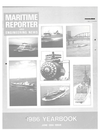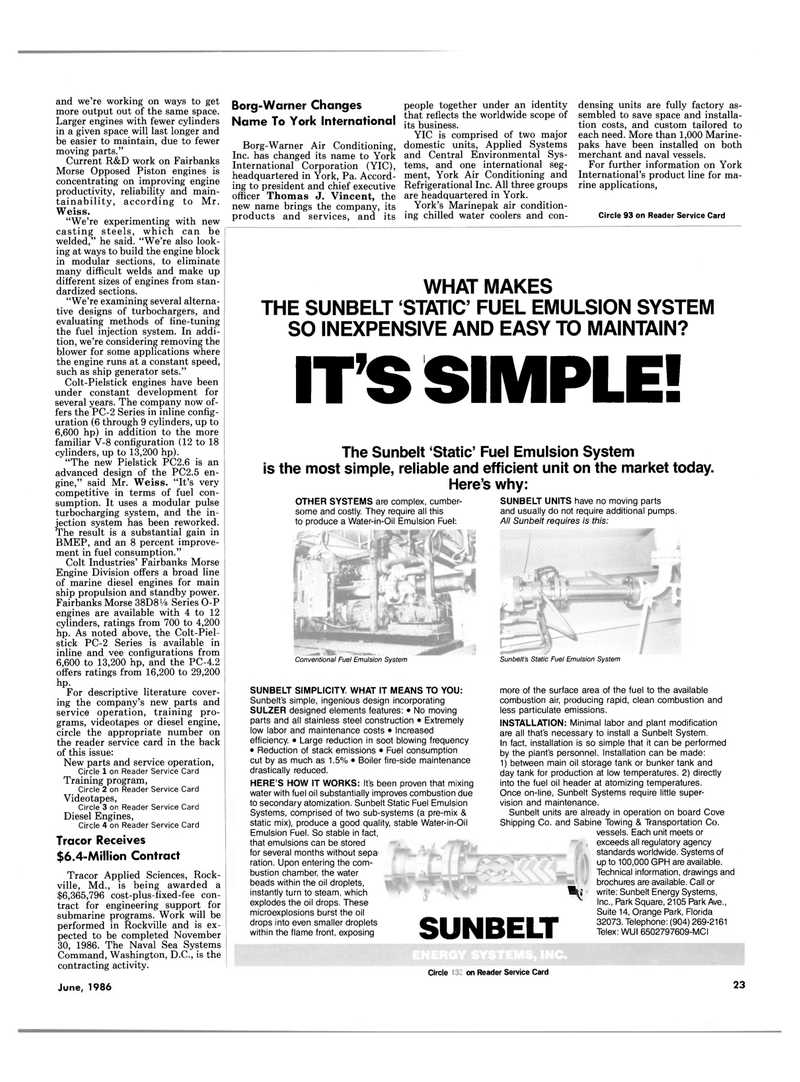
Page 23: of Maritime Reporter Magazine (June 1986)
Read this page in Pdf, Flash or Html5 edition of June 1986 Maritime Reporter Magazine
and we're working on ways to get more output out of the same space.
Larger engines with fewer cylinders in a given space will last longer and be easier to maintain, due to fewer moving parts."
Current R&D work on Fairbanks
Morse Opposed Piston engines is concentrating on improving engine productivity, reliability and main- tainability, according to Mr.
Weiss. "We're experimenting with new casting steels, which can be welded," he said. "We're also look- ing at ways to build the engine block in modular sections, to eliminate many difficult welds and make up different sizes of engines from stan- dardized sections. "We're examining several alterna- tive designs of turbochargers, and evaluating methods of fine-tuning the fuel injection system. In addi- tion, we're considering removing the blower for some applications where the engine runs at a constant speed, such as ship generator sets."
Colt-Pielstick engines have been under constant development for several years. The company now of- fers the PC-2 Series in inline config- uration (6 through 9 cylinders, up to 6,600 hp) in addition to the more familiar V-8 configuration (12 to 18 cylinders, up to 13,200 hp). "The new Pielstick PC2.6 is an advanced design of the PC2.5 en- gine," said Mr. Weiss. "It's very competitive in terms of fuel con- sumption. It uses a modular pulse turbocharging system, and the in- jection system has been reworked.
The result is a substantial gain in
BMEP, and an 8 percent improve- ment in fuel consumption."
Colt Industries' Fairbanks Morse
Engine Division offers a broad line of marine diesel engines for main ship propulsion and standby power.
Fairbanks Morse 38D8Vs Series O-P engines are available with 4 to 12 cylinders, ratings from 700 to 4,200 hp. As noted above, the Colt-Piel- stick PC-2 Series is available in inline and vee configurations from 6,600 to 13,200 hp, and the PC-4.2 offers ratings from 16,200 to 29,200 hp.
For descriptive literature cover- ing the company's new parts and service operation, training pro- grams, videotapes or diesel engine, circle the appropriate number on the reader service card in the back of this issue:
New parts and service operation,
Circle 1 on Reader Service Card
Training program,
Circle 2 on Reader Service Card
Videotapes,
Circle 3 on Reader Service Card
Diesel Engines,
Circle 4 on Reader Service Card
Tracor Receives $6.4-Million Contract
Tracor Applied Sciences, Rock- ville, Md., is being awarded a $6,365,796 cost-plus-fixed-fee con- tract for engineering support for submarine programs. Work will be performed in Rockville and is ex- pected to be completed November 30, 1986. The Naval Sea Systems
Command, Washington, D.C., is the contracting activity.
Borg-Warner Changes
Name To York International
Borg-Warner Air Conditioning,
Inc. has changed its name to York
International Corporation (YIC), headquartered in York, Pa. Accord- ing to president and chief executive officer Thomas J. Vincent, the new name brings the company, its products and services, and its people together under an identity that reflects the worldwide scope of its business.
YIC is comprised of two major domestic units, Applied Systems and Central Environmental Sys- tems, and one international seg- ment, York Air Conditioning and
Refrigerational Inc. All three groups are headquartered in York.
York's Marinepak air condition- ing chilled water coolers and con- densing units are fully factory as- sembled to save space and installa- tion costs, and custom tailored to each need. More than 1,000 Marine- paks have been installed on both merchant and naval vessels.
For further information on York
International's product line for ma- rine applications,
Circle 93 on Reader Service Card
WHAT MAKES
THE SUNBELT STATIC' FUEL EMULSION SYSTEM
SO INEXPENSIVE AND EASY TO MAINTAIN?
IT'S SIMPLE!
SUNBELT SIMPLICITY. WHAT IT MEANS TO YOU:
Sunbelt's simple, ingenious design incorporating
SULZER designed elements features: • No moving parts and all stainless steel construction • Extremely low labor and maintenance costs • Increased efficiency. • Large reduction in soot blowing frequency • Reduction of stack emissions • Fuel consumption cut by as much as 1.5% • Boiler fire-side maintenance drastically reduced.
HERE'S HOW IT WORKS: It's been proven that mixing water with fuel oil substantially improves combustion due to secondary atomization. Sunbelt Static Fuel Emulsion
Systems, comprised of two sub-systems (a pre-mix & static mix), produce a good quality, stable Water-in-Oil
Emulsion Fuel. So stable in fact, that emulsions can be stored for several months without sepa- ration. Upon entering the com- bustion chamber, the water beads within the oil droplets, instantly turn to steam, which explodes the oil drops. These microexplosions burst the oil drops into even smaller droplets within the flame front, exposing more of the surface area of the fuel to the available combustion air, producing rapid, clean combustion and less particulate emissions.
INSTALLATION: Minimal labor and plant modification are all that's necessary to install a Sunbelt System.
In fact, installation is so simple that it can be performed by the plant's personnel. Installation can be made: 1) between main oil storage tank or bunker tank and day tank for production at low temperatures. 2) directly into the fuel oil header at atomizing temperatures.
Once on-line, Sunbelt Systems require little super- vision and maintenance.
Sunbelt units are already in operation on board Cove
Shipping Co. and Sabine Towing & Transportation Co. vessels. Each unit meets or exceeds all regulatory agency standards worldwide. Systems of up to 100,000 GPH are available.
Technical information, drawings and brochures are available. Call or write: Sunbelt Energy Systems,
Inc., Park Square, 2105 Park Ave.,
Suite 14, Orange Park, Florida 32073. Telephone: (904) 269-2161
Telex: WUI 6502797609-MCI •v
SUNBELT
Circle 205 on Reader Service Card
The Sunbelt 'Static' Fuel Emulsion System is the most simple, reliable and efficient unit on the market today.
Here's why:
OTHER SYSTEMS are complex, cumber- some and costly. They require all this to produce a Water-in-Oil Emulsion Fuel:
SUNBELT UNITS have no moving parts and usually do not require additional pumps.
All Sunbelt requires is this:
Sunbelt's Static Fuel Emulsion System Conventional Fuel Emulsion System
June, 1986 23

 22
22

 24
24
